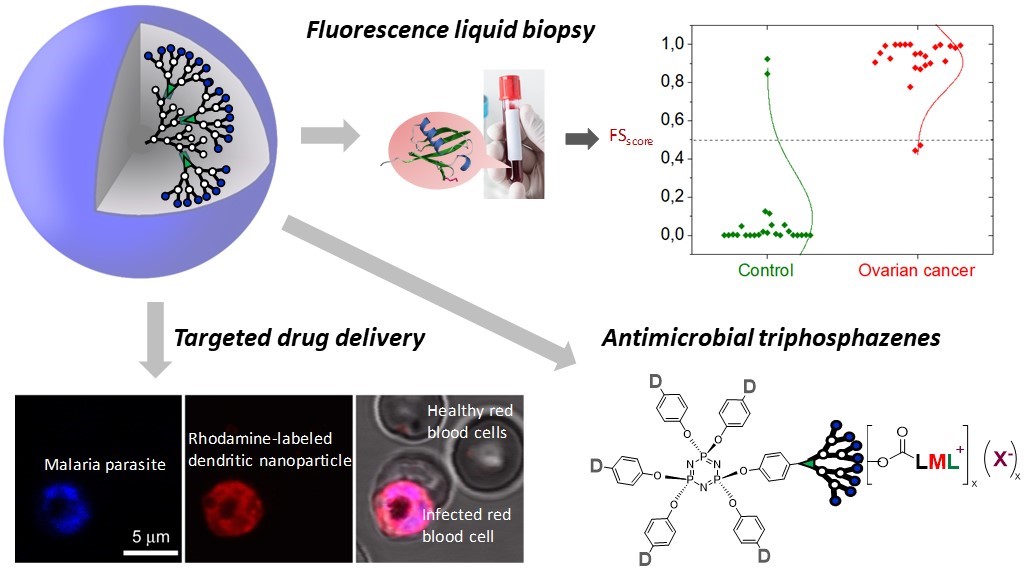Dendrimers and dendritic polymers
 Dendrimers are branched polymers with a repetitive tree-like structure, which consists on a perfectly defined skeleton resulting in almost uniform and monodisperse polymers with a large number of functional groups at the periphery. By extension of the dendrimer concept, dendritic polymers are macromolecules that include such branched structures combined with other polymer architectures. With bis-hydroxymethyl propionic acid (bis-MPA) as a monomer, we are working on hyperbranched polymers grafted with dendrons, and hybrid linear dendritic polymers that contain and alternate two or three blocks with linear and dendritic architecture. The applications of these dendritic polymers are addressed towards drug delivery, mainly for infectious diseases, eg. malaria, tuberculosis, hepatitis C, through the formation of micellar nanocarriers that are targeted to infected cells. Also, these micellar nanoparticles are being explored as a probe for the detection of tumor biomarkers and the early diagnosis of cancer through liquid biopsy methodologies. Their interaction with the proteins of blood serum can be detected by techniques such as fluorescence. Changes of protein contents when a tumor is present determine this interaction, and this can be exploited to differentiate blood serum of cancer and healthy patients. Bis-MPA dendrons are also connected to a cyclotriphosphaze core to attain a biocompatible multiarmed platform for peripheral functionalization with Au(I) and Ag(I) complexes either neutral or cationic, which are directed towards antimicrobial properties.
Dendrimers are branched polymers with a repetitive tree-like structure, which consists on a perfectly defined skeleton resulting in almost uniform and monodisperse polymers with a large number of functional groups at the periphery. By extension of the dendrimer concept, dendritic polymers are macromolecules that include such branched structures combined with other polymer architectures. With bis-hydroxymethyl propionic acid (bis-MPA) as a monomer, we are working on hyperbranched polymers grafted with dendrons, and hybrid linear dendritic polymers that contain and alternate two or three blocks with linear and dendritic architecture. The applications of these dendritic polymers are addressed towards drug delivery, mainly for infectious diseases, eg. malaria, tuberculosis, hepatitis C, through the formation of micellar nanocarriers that are targeted to infected cells. Also, these micellar nanoparticles are being explored as a probe for the detection of tumor biomarkers and the early diagnosis of cancer through liquid biopsy methodologies. Their interaction with the proteins of blood serum can be detected by techniques such as fluorescence. Changes of protein contents when a tumor is present determine this interaction, and this can be exploited to differentiate blood serum of cancer and healthy patients. Bis-MPA dendrons are also connected to a cyclotriphosphaze core to attain a biocompatible multiarmed platform for peripheral functionalization with Au(I) and Ag(I) complexes either neutral or cationic, which are directed towards antimicrobial properties.
Involved researchers: Teresa Sierra (This email address is being protected from spambots. You need JavaScript enabled to view it.
), Luis Oriol, Milagros Piñol, José Luis Serrano, Silvia Hernández, Josefina Jiménez
PhD: Violeta Moncuerde
Key recent publications:
ACS Appl. Polym. Mater., 2023, 5, 381–390. https://doi.org/10.1021/acsapm.2c01553
Biomaterials Sci., 2022, 10, 2706–2719. https://doi.org/10.1039/D2BM00365A
Dalton Trans., 2022, 51, 13657-13674. https://doi.org/10.1039/D2DT01963A
Int. J. Mol. Sci. 2021, 22, 6501. https://doi.org/10.3390/ijms22126501
Biomaterials Sci., 2019, 7, 1661-1674. https://doi.org/10.1039/C8BM01600C
